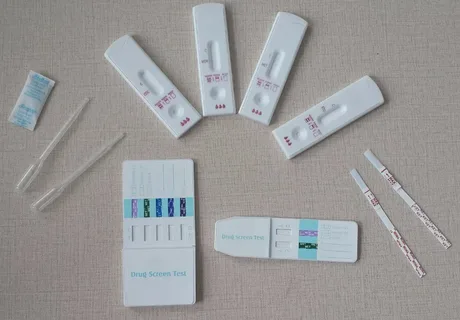The influenza virus, commonly known as the flu, is a highly contagious respiratory illness that affects millions yearly. With symptoms ranging from fever, chills, cough, sore throat, and body aches, it can be difficult to distinguish the flu from other respiratory infections. This is where Flu A/B test kits come in. These test kits are designed to quickly and accurately detect the presence of the influenza A and B viruses in a patient’s body.
Understanding the Basics of Influenza A and B
Influenza, also known as the flu, is categorised into three types: A, B, and C. Influenza A and B are the two types that commonly cause seasonal epidemics in humans. Both A and B types are highly contagious and can lead to severe respiratory illness. Influenza A viruses are more diverse, with multiple subtypes based on two proteins on the virus’s surface – haemagglutinin and neuraminidase. These subtypes can cause severe disease and are also the source of pandemic outbreaks.
In contrast, Influenza B viruses are not divided into subtypes but are categorised into two lineages. They usually cause milder illness but can occasionally be severe. A/B Test Kits are devised to detect these two types of influenza virus and play a pivotal role in controlling the spread of these diseases.
The Mechanism of A/B Test Kits
A/B Test Kits function based on the principle of antigen-antibody reaction. The test strip within these kits contains antibodies specific to Influenza A and B viruses. When a swab sample collected from a patient’s nose or throat is introduced into the kit, it initiates a reaction with these antibodies if the Influenza A or B antigens are present. This interaction triggers a visible signal, commonly a colour change, on the test strip, indicating a positive result.
Without these antigens, no reaction occurs, leading to a negative outcome. It’s important to note, however, that while this method swiftly identifies the presence of influenza, it doesn’t distinguish between different subtypes or lineages of the viruses. The ingenuity of these kits lies in their simplicity and efficiency, providing vital diagnostic information in a matter of minutes.
The Importance of Timely Diagnosis
The timely diagnosis of influenza can be a critical factor in effective management and control. The earlier the detection, the sooner treatment can commence, potentially reducing symptoms’ duration and severity. This swift response can also curtail the spread of the virus to others. A/B Test Kits serve as key tools in achieving this prompt diagnosis, as they can deliver results within minutes.
This immediate feedback can expedite critical decision-making processes, such as initiating antiviral therapy, implementing infection control measures, and advising on time off work or school to limit transmission. Additionally, distinguishing between influenza and other respiratory illnesses through timely diagnosis can prevent unnecessary use of antibiotics, thereby helping in the global fight against antibiotic resistance. Therefore, the relevance of timely diagnosis in managing influenza, facilitated by A/B Test Kits, must be considered.
The Pros of Using A/B Test Kits
The use of A/B Test Kits is accompanied by several benefits and drawbacks that are essential to consider.
• Advantage:
Quick results – A/B Test Kits deliver results within minutes, expediting the decision-making process in clinical settings.
• Advantage:
Specific to Influenza A and B – These kits have antibodies that specifically detect Influenza A and B, contributing to their high accuracy.
• Advantage:
Control measures – Timely detection facilitates the implementation of effective control measures, reducing the virus spread.
Whilst the A/B Test Kits are acknowledged for their time efficiency and specificity, the limitations related to false results and subtype identification are vital to bear in mind. Additionally, the reliability of the test outcome is contingent on the optimal timing and procedure of sample collection. This complex interaction of pros and cons guides their use in the battle against influenza.
The Future of A/B Test Kits
The path ahead for A/B Test Kits holds immense promise, marked by continuous advancements in biomedical science. Increasing the specificity and sensitivity of these kits and their ability to differentiate between subtypes of the influenza virus are among the key areas of focus. Newer techniques, like multiplex testing, can offer the potential for a more comprehensive diagnostic profile, simultaneously identifying multiple Influenza A and B strains.
Innovations are also surfacing in digital health, with technological tools providing data integration and analysis capabilities to enhance the utility of these kits. Additionally, strides are being made towards developing test kits that deliver even faster results without compromising accuracy.
Such enhancements can substantially augment the role of these kits in disease management, patient care, and epidemic control. The future of A/B Test Kits, thus, looks towards an era of increased precision, speed, and insight, transforming the landscape of influenza diagnosis and management.
 Detecting Flu with A/B Test Kits
Detecting Flu with A/B Test Kits
A/B Test Kits have proved to be invaluable in the detection of Influenza A and B. The process begins with collecting a swab sample from a patient’s nasal or throat passage. Once collected, the sample is introduced into the kit, instigating a reaction with the antibodies on the test strip. If the patient’s sample contains antigens specific to Influenza A or B, an interaction occurs, resulting in a visible change on the test strip – typically a colour shift. This signifies a positive result.
Without these specific antigens, no reaction transpires, leading to a negative result. The rapidity and specificity of these kits greatly facilitate the detection process, enabling the swift initiation of appropriate treatment measures. However, their limitations, such as the inability to differentiate between various subtypes of the virus and the potential for false results, necessitate careful interpretation of the test results in conjunction with other clinical evidence.
A/B Kits: Fast and Accurate Diagnosis
The crux of A/B Test Kits’ utility lies in their speed and accuracy. The simplicity of the procedure, coupled with the rapid return of results, enables timely clinical decision-making. Within minutes, these kits can confirm the presence or absence of Influenza A or B antigens in a patient’s sample. Their specificity in detecting these two main types of influenza contributes significantly to their high level of accuracy.
However, whilst their speed is commendable, the accuracy is not absolute. Instances of false negatives or positives can occur, although they are rare.
Furthermore, the test kits’ inability to differentiate between different virus subtypes may limit the depth of diagnostic insight. The use of these kits, therefore, should be complemented with other clinical evidence for a more holistic diagnostic perspective. Thus, A/B Test Kits, with their quick turnaround time and high specificity, offer an efficient approach to influenza diagnosis, albeit with a few limitations.
Accuracy of A/B Test Kits
The precision of A/B Test Kits is generally highly regarded, owing to their specificity in detecting antigens exclusive to Influenza A and B. This, paired with the swift delivery of results, underscores their accuracy. Nevertheless, this accuracy is not absolute. Whilst the incidence of false negatives or positives is quite low, it remains a pertinent limitation. This risk of erroneous results can vary depending on the timing and procedure of sample collection, rendering these factors vital for achieving accurate outcomes.
Furthermore, the inability of these kits to identify specific subtypes of the influenza virus may impede comprehensive diagnostic insight. Therefore, whilst the A/B Test Kits display significant accuracy in detecting Influenza A and B, it’s essential to interpret the results in conjunction with other clinical findings to ensure a more reliable and holistic diagnostic perspective.
Innovations in Flu A/B Testing
Technological advancements and biomedical research are constantly propelling innovation in the realm of Flu A/B testing. Current focus areas include enhancing the specificity and sensitivity of test kits and their ability to discern between various virus subtypes. One such promising development is multiplex testing. This cutting-edge approach allows for the simultaneous identification of multiple Influenza A and B strains, thus providing a more comprehensive diagnostic profile.
Concurrently, strides are being made in digital health, with technology-enhanced data analysis and integration augmenting the utility of these kits. This merging of healthcare and technology has the potential to streamline diagnosis, enhance patient management, and facilitate epidemic control. Furthermore, research is underway to engineer test kits that yield faster results without compromising accuracy, maximising their efficiency in clinical settings.
As innovation continues to reshape the landscape of Flu A/B testing, the future holds immense promise for more precise, rapid, and insightful diagnostic tools.
Limitations of Influenza A/B Test Kits
Despite their invaluable role in influenza A/B Test Kits are full of certain limitations.
• Limited subtype information:
Whilst these kits effectively detect Influenza A and B, they do not provide information on specific virus subtypes or lineages.
• Potential for false results:
Although rare, there is a possibility of false negatives or positives affecting the accuracy of the diagnosis.
• Dependence on sample collection:
The reliability of the test outcome is contingent on the timing and procedure of sample collection, which may vary.
• Need for clinical correlation:
Results should be interpreted with other clinical findings for a holistic diagnostic perspective.
• Not a standalone solution:
These kits should be used as part of a comprehensive approach to influenza diagnosis and management and not as a standalone solution. Hence, whilst A/B Test Kits offer rapid and specific detection of influenza, these limitations necessitate their use within a wider clinical evaluation and judgement context.
FAQ’s
1. What is the main principle behind the operation of Influenza A/B Test Kits?
The Influenza A/B Test Kits function on the principle of antigen-antibody reaction. Antibodies within the kits react with Influenza A or B antigens, if present in the patient’s sample, triggering a visible signal for a positive result.
2. Can A/B Test Kits detect specific subtypes or lineages of the virus?
The kits cannot differentiate between various subtypes of Influenza A or the lineages of Influenza B. They only provide a general detection of the presence of these viruses.
3. How accurate are these test kits?
While they offer a high degree of accuracy due to their specificity, the possibility of false positives or negatives remains, albeit low. The timing and procedure of sample collection can also influence their accuracy.
4. Can the kits be a standalone solution for influenza diagnosis?
These kits should be part of a comprehensive approach to influenza diagnosis and management rather than a standalone solution. They offer valuable initial diagnostic information, but results should be correlated with other clinical evidence.
5. What does the future hold for A/B Test Kits?
The future of these kits looks promising, with ongoing advancements focusing on increasing specificity and sensitivity, differentiation between virus subtypes, and rapid results. Digital health and multiplex testing innovations are also poised to reshape the diagnostic landscape.
Conclusion
In conclusion, Flu A/B test kits play a significant role in the early detection of influenza, thereby aiding in disease management and epidemic control. Despite certain limitations, their speed and specificity render them critical diagnostic tools. Future developments focused on increased precision and rapid results, alongside innovative techniques like multiplex testing and digital health integration, promise to enhance their utility.
Hence, the role of A/B test kits in influenza diagnosis is set to become increasingly pivotal, underscoring the need for continued research and innovation in this area.
| Related Business Listings |
| Contact Directory |
| Local Business Profiles |

